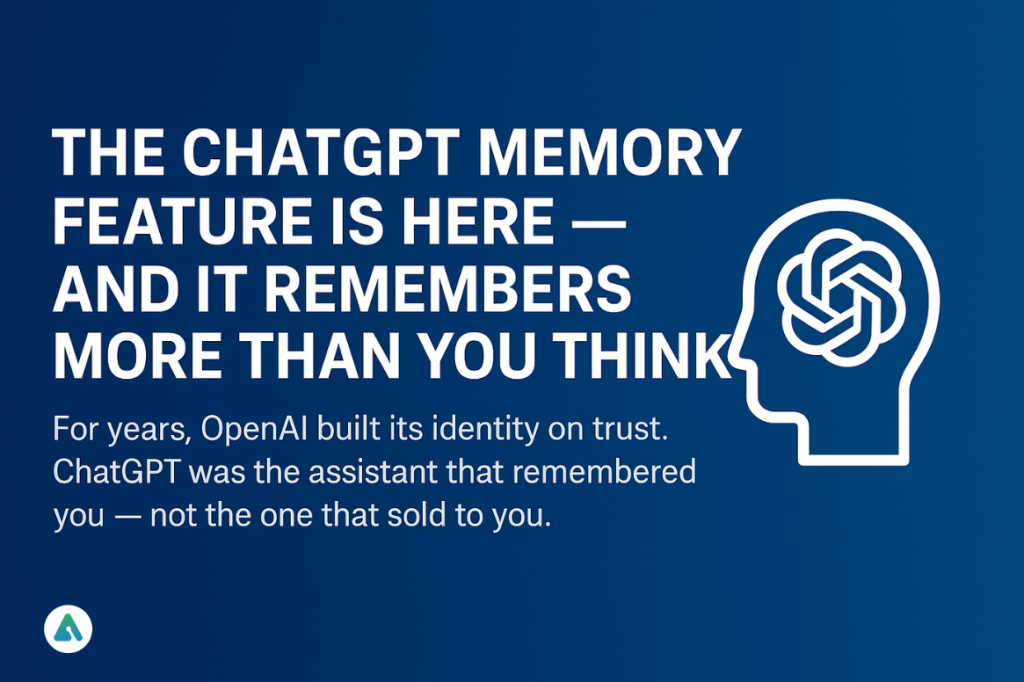For years, OpenAI built its identity on trust. ChatGPT was the assistant that remembered you — not the one that sold to you.
But new ChatGPT memory feature expands, and the company moves deeper into platform territory, a new question is emerging:
What happens when remembering turns into recommending?
The company that once positioned itself as an antidote to attention-driven platforms is now quietly assembling the building blocks of a future where memory, personalization, and commerce blend into one continuous flow of interaction.
Memory Is the New Interface
The premise of ChatGPT’s memory sounds innocent enough: it remembers your name, your preferences, and your style of communication.
But this isn’t just about convenience. It’s about creating persistent context — a digital reflection of your habits and needs.
And persistent context is incredibly valuable.
Imagine this:
You ask ChatGPT for dinner ideas.
It remembers you’re a vegetarian, living in Seattle, and that you once mentioned liking quick recipes.
It generates a recipe, but this time, it also says —
“Would you like me to order the ingredients from your preferred grocery service?”
One tap later, you’re not just chatting — you’re shopping, friction-free.
That’s ambient monetization: commerce woven invisibly into conversation, powered by the AI’s memory of you.
From Chatbot to Platform
Behind the scenes, OpenAI has been evolving from an app into a full-stack platform. Developers can now create mini-apps and plug-ins inside ChatGPT. The company has hinted that these tools will eventually integrate more seamlessly with user context — making the assistant feel less like software and more like a personalized operating system.
In practical terms, this means:
- Developers can build “memory-aware” apps that use user data for custom responses.
- ChatGPT can now browse, summarize, and suggest content dynamically.
- APIs like “context connectors” allow external services (think retailers, media platforms, or productivity tools) to plug into your AI workspace.
- And with the arrival of its new integrated browser, the AI ecosystem is expanding fast — as detailed in ChatGPT Atlas: The AI Browser That Works for You (and Watches You), which explores how OpenAI’s browsing model is redefining user interaction and data flow.
All of this sets the stage for what’s next: contextual recommendations that don’t look like ads — but function exactly like them.
The Economics Behind the Shift
Running a frontier AI model isn’t cheap. The infrastructure, training, and scaling costs are staggering.
Subscriptions alone won’t sustain it, especially as usage grows faster than paid conversion rates.
That’s why the memory feature isn’t just a product improvement — it’s an economic shift.
More personalization leads to more engagement; more engagement leads to more opportunities to monetize.
The difference is that instead of banner ads or pop-ups, monetization here happens through contextual intelligence.
It’s a system that sells by suggestion — not interruption.
The Trust Paradox
Here’s where it gets tricky.
Users want their AI to remember them. It’s what makes interactions smoother, more natural, more human.
But that same intimacy can erode trust if it’s used to sell — even subtly.
When an assistant starts offering solutions that align too perfectly with your past behavior, it stops feeling like intuition and starts feeling like influence.
And because memory-based AI draws from private context — not public search — users may never fully know when a suggestion is organic or incentivized.
The ethical tension isn’t about transparency alone; it’s about agency.
If your assistant knows what you want before you do, who’s actually in control of the decision — you or the algorithm that remembers you?
Why This Direction Is Inevitable
- Economic Gravity: Free AI access doesn’t scale without secondary revenue streams. Monetization is a matter of survival.
- Platform Ambition: OpenAI is no longer just building a chatbot — it’s constructing an ecosystem for developers, creators, and businesses.
- User Expectation: The more “human” an assistant becomes, the more natural it feels to ask it to do things like shop, plan, or recommend.
- Competitive Momentum: Other AI companies are already experimenting with embedded commerce, smart search, and contextual shopping.
Put simply, personalization is the new monetization. The challenge isn’t whether it happens — it’s how honestly it’s done.
A Future Built on Quiet Nudges
The next phase of AI won’t rely on explicit ads. Instead, it’ll depend on suggestive flow: subtle, memory-driven nudges that feel like personal advice.
Expect “partner integrations” that appear as extensions of your chat experience — a travel bot that remembers your favorite airlines, a learning assistant that recommends paid courses from your go-to platforms, a finance module that connects your spending habits with “trusted partners.”
No pop-ups. No banners. Just a perfectly timed offer inside a trusted voice.
The magic — and the risk — lies in how invisible it all feels.
The Bottom Line: When Help Turns into Influence
The future of AI isn’t about machines replacing people; it’s about interfaces replacing intent.
As OpenAI transforms from a product into an ecosystem, its greatest asset — memory — is becoming its most powerful monetization engine.
The promise of AI assistance was always rooted in trust. But when your assistant starts remembering not just who you are but how you buy, that trust faces a new kind of test.
The next great disruption won’t shout at you from a sidebar.
It’ll whisper — in a tone that sounds a lot like your own.
Visit: AIInsightsNews


